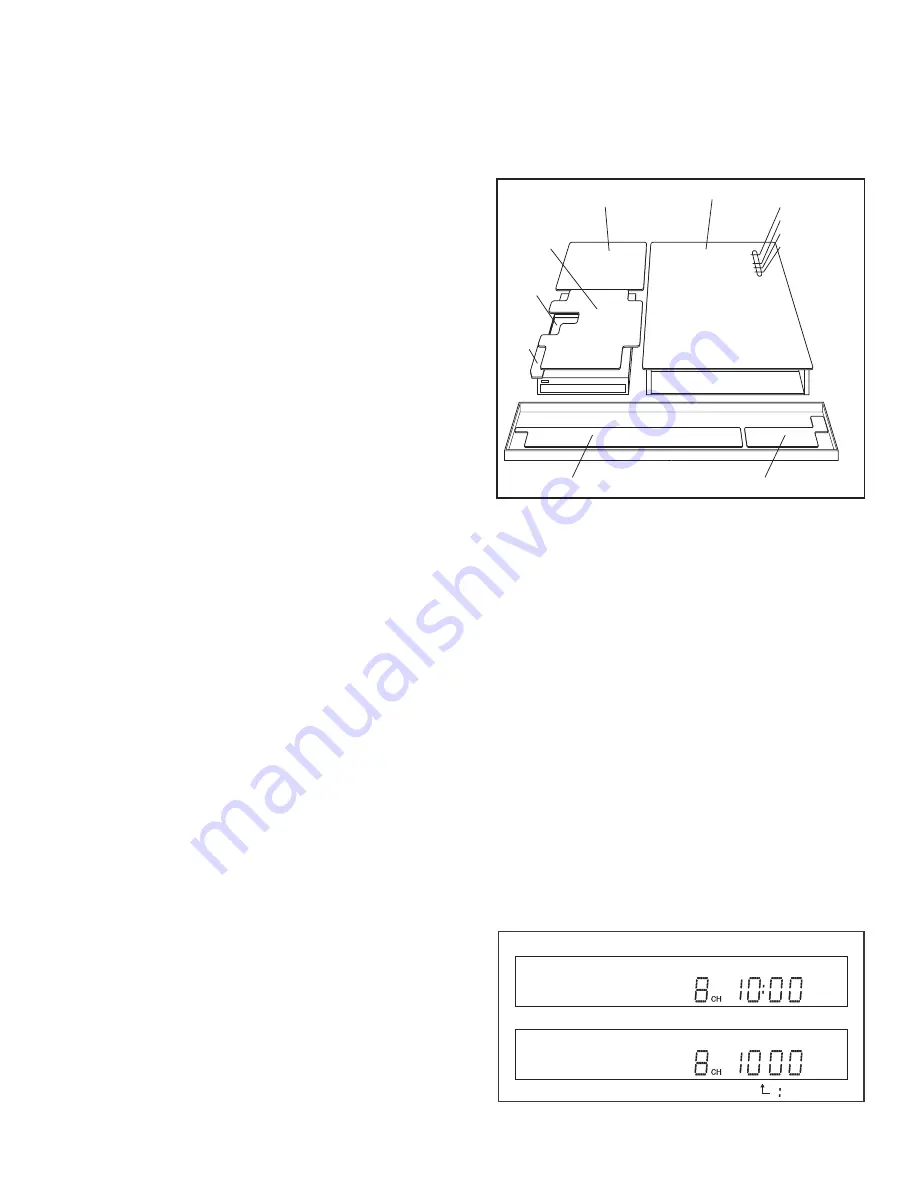
(No.YD006)1-5
SECTION 2
SPECIFIC SERVICE INSTRUCTIONS
2.1 Service position
This unit has been designed so that the Mechanism and Main
board assemblies can be removed together from the bottom
chassis. Before diagnosing or servicing the circuit boards, take
out the major parts from the bottom chassis.
2.1.1 How to set the "Service position"
(1) Refer to the disassembly procedure and perform the disas-
sembly of the major parts before removing the Mechanism
assembly.
(2) Remove the screws that fix the Mechanism, Main board as-
sembly to the bottom chassis. If any other screws are used
to fix the boards, remove them also.
(3) Remove the combined Mechanism, DVD unit, regulator,
digital, junction and Main board assemblies.
(4) If any other major parts are used, remove them also.
(5) Connect the wires and connectors of the major parts that
have been removed in steps (1) to (4). (Refer to Fig. 2-1a.)
(6) Place the combined Mechanism, Main board and other
board assemblies upside down.
(7) Insert the power cord plug into the power outlet and then
proceed with the diagnostics and servicing of the board as-
sembly.
Notes:
•
Before inserting the power cord plug into the power out-
let, make sure that none of the electrical parts are able
to short-circuit between the workbench and the board
assembly.
•
For the disassembly procedure of the major parts and
details of the precautions to be taken, see "Removing
the major parts".
•
If there are wire connections from the Main board and
Mechanism assemblies to the other major parts, be sure
to remove them (including wires connected to the major
parts) first before performing step (2).
•
When carrying out diagnosis and repair of the Main
board assembly in the "Service position", be sure to
ground both the Main board and Mechanism assem-
blies. If they are improperly grounded, there may be
noise on the playback picture or FDP counter display
may move even when the mechanism is kept in an inop-
erative status.
•
In order to diagnose the playback or recording of the
cassette tape, set the Mechanism assembly to the re-
quired mode before placing it upside down. If the mech-
anism mode is changed (including ejection) while it is in
an upside down position the tape inside may be dam-
aged.
•
For some models, the mechanism and board assem-
blies are attached by connectors only. When carrying
out a diagnosis or repair of the boards in the "Service
position", make sure that the connectors are not dis-
connected.
Fig.2-1a
2.2
Jig RCU mode
This unit uses the following two modes for receiving remote con-
trol codes.
(1) User RCU mode:Ordinary mode for use by the user.
(2) Jig RCU mode: Mode for use in production and servicing.
When using the Jig RCU, it is required to set the VCR to the Jig
RCU mode (the mode in which codes from the Jig RCU can be
received). As both of the above two modes are stored in the EE-
PROM, it is required to set the VCR back to the User RCU mode
each time that an adjustment is made or to check that the neces-
sary operations have been completed.These modes can be set
by the operations described below.
Note:
•
When the unit is set to JIG mode and when the unit is
under JIG mode, the remote control unit attached to
product operates only in "Remote Control Code 1".
Since the unit is in "Remote Control Code 3" when it is
shipped and just after its batteries are changed, "Re-
mote Control Code 3" needs to be changed to "Remote
Control Code 1."
•
Confirm the RCU mode when exchanged parts. Since
some SERVICE PARTS sets the VCR to the Jig RCU
mode as initial setting. Therefore please set the VCR to
the user RCU mode after replacing the EEPROM.
Fig.2-2a User/Jig RCU mode
TP111 D.FF
TP106 PB FM
TP2253 A.PB FM
TP4001 CTL.P
Main board assy
Regulator board assy
Switch display board assy
Operation jack board assy
Jack
board
assy
Digital
board
assy
Junction
board
assy
( blinked)
Jig RCU mode
User RCU mode
Summary of Contents for DR-MV1SUS
Page 23: ... No YD006 1 23 ...






































